Top 15 digital workplace and intranet blog posts from DWG in 2015
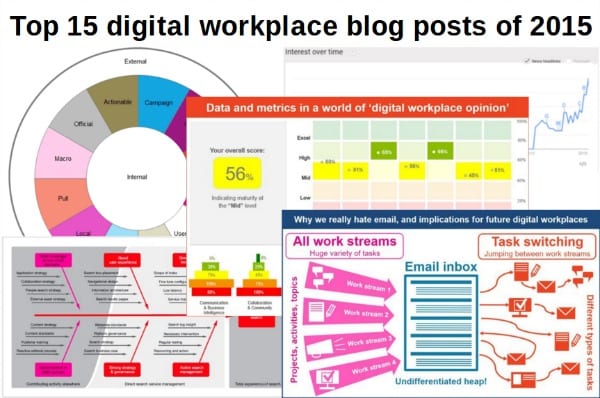
2015 looks to have been a pivotal year for the digital workplace concept. This article looks at the top DWG blog posts about intranets and the digital workplace in 2015, and highlights the key themes that surfaced.
The digital workplace is here, and it’s about… everything
Let it be written in the history books: 2015 was the year that the “digital workplace” concept took hold and reached a key threshold of acceptance.
And in 2015 many throughout the industry made it clear that the digital workplace is as much about organizational culture, leadership, talent and employee experience as it is about technology. Similarly, a review of 2015 highlights the fact that digital workplaces are not just about technology implementation, but about the roles of the tools, such as internal communication, collaboration and productivity, knowledge sharing and building community. Similarly, digital workplace success relies not just on project planning, but on strategy, governance, stakeholder engagement, user experience design (UXD), metrics and more.
The bottom line: 2015 laid the groundwork for organizations to understand the profound potential of digital workplaces to transform the employee experience and drive great value.
So, without further ado, what were the top Digital Workplace Group articles of 2015?
1: Picking the right channel: a guide for Internal Communications practitioners
The popularity of this blog post by DWG researcher Cheryl Lesser highlighted a few key things:
- Internal Communications is still a core function of the digital workplace and intranet.
- Digital and physical channels are still both important and must be integrated.
- Internal Communications is transforming and growing more complex, with more channels and opportunities than ever before.
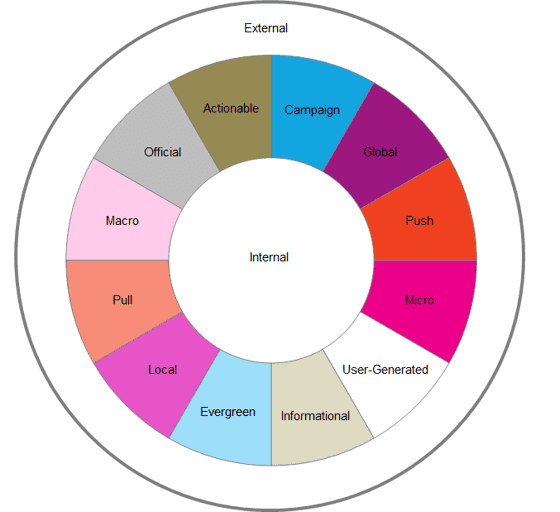 We sourced this blog post and the accompanying “content wheel” diagram from our research report Digital Channel Matrix: Creating employee-focused communications. The full report is accessible to DWG members, and the free executive summary is available to the public.
We sourced this blog post and the accompanying “content wheel” diagram from our research report Digital Channel Matrix: Creating employee-focused communications. The full report is accessible to DWG members, and the free executive summary is available to the public.
2: Which of these 8 definitions of “digital workplace” works best for you?
The popularity of this post demonstrates that in 2015 many in the industry were seeking a deeper understanding of the “digital workplace” concept in earnest. Perhaps most importantly, this article proposed a definition that put employee experience at the forefront, which is a concept that has gained a lot of momentum in 2015.
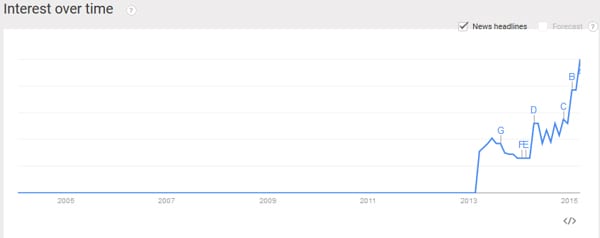 Google Trends data on the growing use of the term “digital workplace”
Google Trends data on the growing use of the term “digital workplace”
As organizations seek to define “digital workplace” in a way that works for their contexts, they are also seeking to set future visions of digital working and to plot out roadmaps.
A recently published DWG Consulting case study describes a digital workplace innovation lab. This service helps organizations start to build a future vision based on industry insights and peer learning.
3: 8 change management strategies for intranet and digital workplace projects
You’ll hear a lot about “organizational culture” and “change management” in reference to the digital workplace these days, and for good reason.
If you look at any major digital workplace project through the lens of change management, you’re sure to improve your chances of success. Thought leaders and consultants throughout the industry have been very clear on this point.
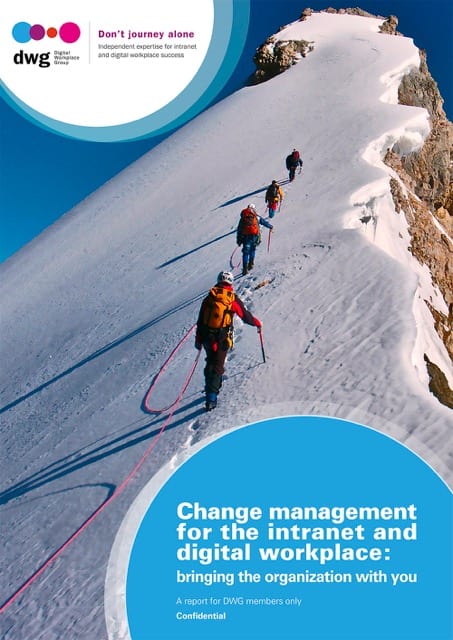
Article #3 on this list sprang from DWG’s 2015 research report on Change management for the intranet and digital workplace by DWG Researcher and Benchmarker, Steve Bynghall. The article lists key themes that emerged from the research. The research report itself includes real-world case studies from large organizations and analysis of industry best practice. This research, along with other reports, is part of the DWG Research Programme, which is a core pillar of DWG’s Member Forum.
4: The best enterprise search diagram you’ve ever seen
Oh, enterprise search. You rascal you. You ethereal fog of seemingly ungraspable goals and needs.
I swear that at DWG Member Meetings in 2015 I heard the term “metadata” more often than in any prior year. In the emerging era of the digital workplace perspective, enterprise search is becoming more important than ever before. In the age of information, finding what you need at the right time is becoming both more important and more of a challenge.
While the technology itself is only advancing incrementally, the industry’s understanding of how to make search work well is growing, with more and more examples of success.
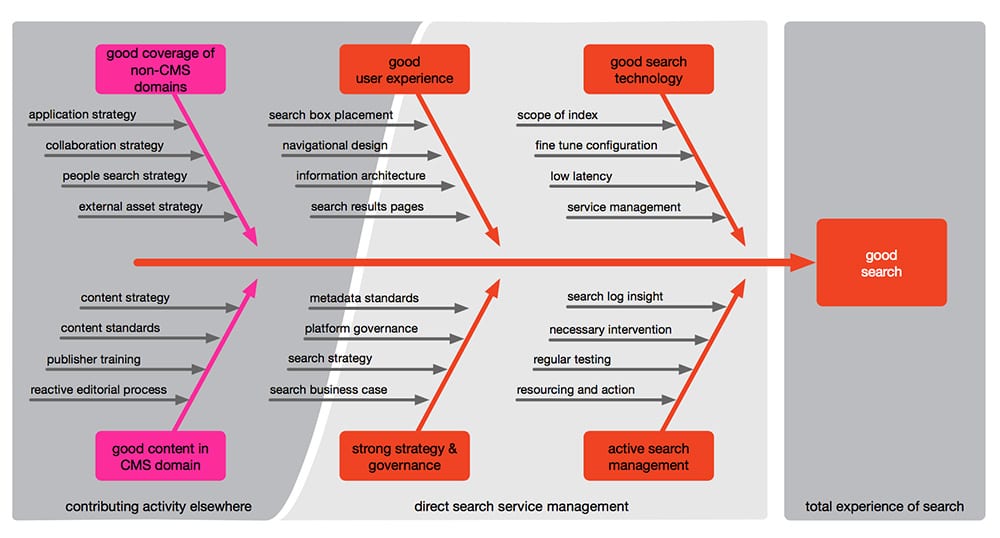 This search diagram and the accompanying article come from DWG’s 2015 research report Intranet Search: A holistic approach to management by DWG Digital Workplace Consultant Chris Tubb. The report demonstrates the increasingly well-known fact that good search is as much about the content, strategy and governance, as it is about the technology.
This search diagram and the accompanying article come from DWG’s 2015 research report Intranet Search: A holistic approach to management by DWG Digital Workplace Consultant Chris Tubb. The report demonstrates the increasingly well-known fact that good search is as much about the content, strategy and governance, as it is about the technology.
5: Analysis of Gartner’s “8 building blocks for the digital workplace”
While DWG has been actively promoting the digital workplace concept since 2010, the year 2015 saw many major organizations actively join in the industry dialogue. In an effort to grab an industry snapshot, DWG analysed the public materials about the digital workplace from Gartner, Avanade (see below) and Deloitte.
While Gartner’s building blocks may have been light on governance and UXD, they touch upon a lot of important topics and also reference the importance of digital workplace benchmarking. With our history of intranet and digital workplace benchmarking, this was a welcome nod. If you’re not already familiar with it, DWG’s digital workplace maturity benchmark is the first comprehensive, standardized evaluation on the market that looks at an organization’s digital workplace across usability, core purposes, governance and strategy.
6: Decoding Avanade’s digital workplace approach and language

As with our post assessing Gartner’s digital workplace thinking, our analysis of Avanade’s public digital workplace thinking attracted a lot of attention.
Generally speaking, Avanade’s combination of Microsoft’s technology focus with Accenture’s management consulting focus seems to have yielded a thoughtful and balanced perspective on the digital workplace – which is always what we’re looking for in someone’s digital workplace thinking.
In 2016 I expect we’ll see many more large organizations weighing in on the digital workplace topic, which will hopefully lead to productive dialogues rather than hyperbolic marketing.
7: What is the relationship between organizational culture and the digital workplace?

Goodness. Culture. This one seven-letter word sure carries a lot of baggage and complexity!
Starting in 2014 we saw a lot of digital workplace leaders exploring the question of what organizational culture factors could foster effective digital workplace programmes. While not a simple question, it’s an important one that requires exploration.
Article #7 in our list, by Digital Workplace Researcher and Consultant Shimrit Janes, tapped a vein of interest in the industry and laid out some core concepts on the topic. Our recent follow-up article went into more specific and prescriptive detail: Which cultural values can help and hinder an effective digital workplace programme?
Culture is hard to shape and tough to change. But it’s critical for both digital workplace success and organizational success. I suspect we’ll see plenty more on this topic in the coming year.
8: Do you have a Chief Employee Experience Officer (CEEO) leading your digital workplace?
How do I summarize? Modern organizations structure their operational functions in a way that’s antithetical to successful digital workplace projects, and most organizations seriously lack internal UXD capabilities.
In 2015 the “design thinking” concept captured a lot of attention. Similarly, we seem to be seeing better and better resourced digital workplace teams at large organizations. At the core of all of this is a focus on the employee experience of work and how organizations can manage that, rather than managing technology in a siloed way.
 Article #8 resonated with many industry thinkers and noted a trend within leading organizations. For example, earlier this year AirBnB, the highest rated employer on Glassdoor as reported by Business Insider, created a “CEEO” role. Coincidence? I think not.
Article #8 resonated with many industry thinkers and noted a trend within leading organizations. For example, earlier this year AirBnB, the highest rated employer on Glassdoor as reported by Business Insider, created a “CEEO” role. Coincidence? I think not.
Expect to see much more about “employee experience” in 2016!
9: Why we really hate email, and implications for future digital workplaces
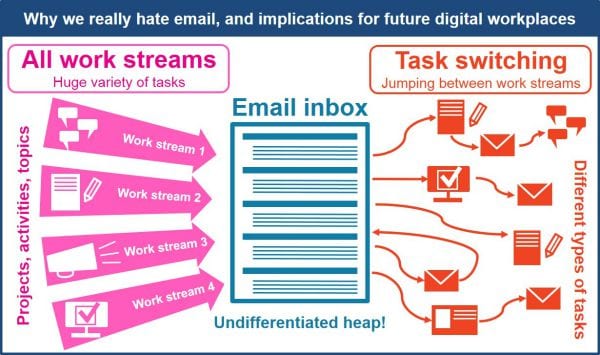 Perhaps it’s easy to take a shot at email, the perennially despised torture chamber many of us simply can’t escape. At least, that’s one common sentiment on the matter.
Perhaps it’s easy to take a shot at email, the perennially despised torture chamber many of us simply can’t escape. At least, that’s one common sentiment on the matter.
But article #9 on our list was not so much about criticizing email as analysing why it causes us trouble and what we can learn about the design of future digital workplaces.
In 2015 more and more services that aim to tie disparate and fragmented digital workplace tools together came on the market and/or gained popularity. Similarly, among DWG members in 2015, we saw continued interest around integrated task lists on the homepage.
In 2016 expect to hear much more from vendors and tools that focus on making digital tools work better together and better for employees.
10: The 7 levels of HR integration into the intranet
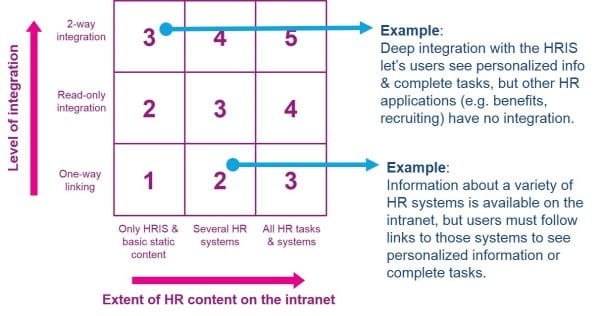
Near the top of the list of enterprise software systems that aren’t going away any time soon: Human Resources Information Systems (HRIS) and related systems focused on specific employment benefits.
The bad news is that the average company provides a plethora of highly varied HR systems for employees to navigate, and many of those systems are poorly designed. The good news is that we’re seeing more and more personalized integration of these systems on leading intranets. This means a more consistent and pleasant user experience, greater efficiency and fewer frustrating moments of logging in to yet another system.
Article #10 on our list provides a fairly simple framework for looking at how well your HR systems are integrated with your intranet. But don’t place too much on simple analyses like these; in order to understand how well you’re doing, you need real apples-to-apples benchmarking with other large organizations.
11: SLIDESHOW: 30+ lessons from 12 leading intranet homepages
 If there’s one thing we’ve learned at DWG over the years, it’s that people like seeing other people’s intranets!
If there’s one thing we’ve learned at DWG over the years, it’s that people like seeing other people’s intranets!
Article #11 on our list pulls out real-world examples and themes from the many intranets shown on Digital Workplace 24 in 2015 (remember that old thing!).
This post in particular captures some of the key intranet and digital workplace trends from 2015 – in pictures!
12: 7 ways to create IKEA’s ‘fika’ in the digital workplace
 Related to above references to organizational culture, this excellent post from DWG CEO Paul Miller explores how digital workplaces can foster strong, positive cultures.
Related to above references to organizational culture, this excellent post from DWG CEO Paul Miller explores how digital workplaces can foster strong, positive cultures.
After a visit to the headquarters of IKEA (a DWG member), Paul reflected on how digital experiences can support the hard-to-translate term “fika”, which is popular at IKEA. Understanding how digital workplaces can strengthen the good parts of organizational cultures will be a critical next stage in the maturation of the digital workplace concept.
13: My 10 digital workplace predictions for 2016
Another top post from 2015 was Paul’s predictions for 2016. These articles from Paul are perennial favourites and always trigger good discussions.
Paul has a 70% accuracy track record for his predictions (self-scored), so it’s worth paying attention to the trends he highlights (well, at least 70% of your attention anyway).
After working with the intranet and digital workplace teams and senior leaders at large organizations for over 12 years, Paul is perfectly positioned to spot key trends. This, coupled with his unrivalled interest in the future of work, make Article #13 on our list a must-read.
14: Data and metrics in a world of ‘digital workplace opinion’

There’s nothing like a little data to help make an informed decision. Digital workplace decision-making can be rife with organizational politics. But the skies seem to clear and the sun breaks through the fog when real, relevant data come into the discussion.
This popular post highlighted the importance of using data in making decisions with stakeholders, a practice that will only gain value in the age of “big data”.
Three key sources of data for digital workplace decision-making include:
- Results from UXD exercises.
- Examples from other comparable organizations that highlight best practice.
- Apples-to-apples benchmarking comparisons.
There are a variety of intranet and digital workplace benchmarking services out there, but some are based purely on user-reported data or have immature evaluation frameworks. DWG’s intranet benchmarking and digital workplace maturity benchmark provide the most sophisticated comparison data available. And our membership model allows for confidential comparison to other large organizations, a rarity.
15: How 2 companies leveraged social intranets to turn around culture and revenue
This popular blog post from a guest author tied together the popular theme of social intranets (enterprise collaboration, enterprise social networking, social business, knowledge sharing, etc.) with the recurrent theme from 2015 of organizational culture.
The two examples demonstrate how enterprise social software, while not capable on its own of transforming organizational culture, can be a critical catalyst. Especially in geographically dispersed organizations, social intranets can foster connection, community, open communication, collaboration, transparency, knowledge sharing, innovation and trust.
2015: An overall maturing on digital workplace thinking
Overall, the core theme that emerges from DWG’s top 15 blog posts from 2015 and from the industry overall is: maturity.
The digital workplace concept gained a foothold in the common parlance of our times. Large organizations are starting to invest in digital workplace strategies and programmes. The industry is taking a close look at organizational culture, and shifting focus from technology to employee experience.
If I had to use a poor metaphor, I’d say that in 2015 the digital workplace graduated from high school (secondary school if you will) and can now vote in elections (and, depending where you are, drink beer in pubs).
Categorised in: Digital workplace
